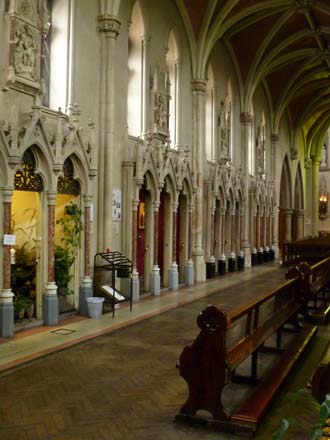











 The church of St. Peter’s is an historic building of some considerable
The church of St. Peter’s is an historic building of some considerable
significance. It is a fine example of a Victorian Catholic Church in a dramatic
and prominent location. It is also a much-loved, sacred place with a strong
spiritual resonance that remains in regular use as a place of worship for the
immediate locality. Fortunately the historic fabric of the church remains in a
good state of preservation and is in a reasonable state of repai. The exception
to this are the rainwater goods, the roofs to the aspe on the west side and the
flat roofs to the side entrances, the windows and railings. These need urgent
attention to avoid even higher repair costs further down the road. The satined
glass windows are of good quality but have also been affected by inappropriate
interventions and will at a later stage need to be redressed.
The
most urgent actions for the conservation of the church are attending the leaks
to all the roofs and to improve safety of access to these areas. In a building
of this age, it is inevitable that a number of Health and Safety concerns
should arise. Among these, the foremost are the asbestos lagging which needs to
be removed and the belfry which will have to be made secure from pigeons.
The
original parquet flooring in the church is uneven and should be repaired and
made level. The concrete pavement at the front entrance of the church will also
have to be levelled.
New
electrical and lighting services are needed and the front railings of the
church are in a vulnerable condition and will need to be prepared as well. St.
Peter’s Church is a large, complex structure and issues of maintenance and
repair will require regular attention. The health of any historic building
depends on the heating and ventilation that occurs in its regular use and the
existing heating and ventialting system will also require attention.
We at St. Peter’s, in conjunction with our Conservation Architects,
Howley Hayes Architects have adopted a minimal intervention policy – a
philosophy of doing as little as possible but as much as necessary which we
believe will achieve the best conservation practice at the least cost